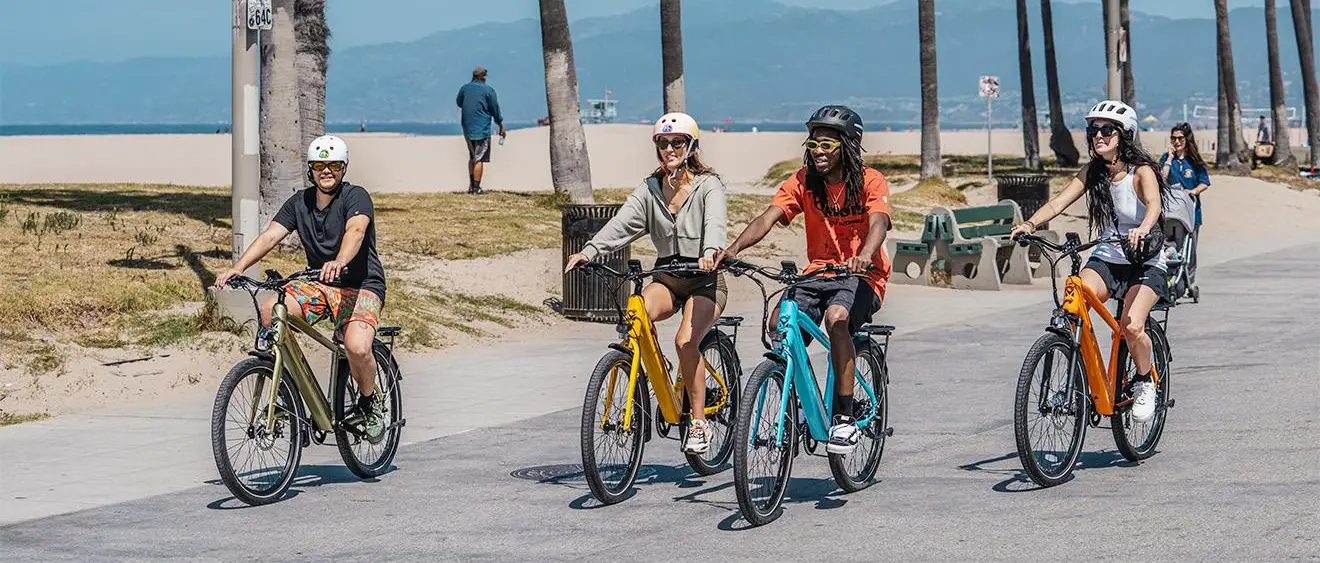Last Updated on October 22, 2023 by Igor Karni
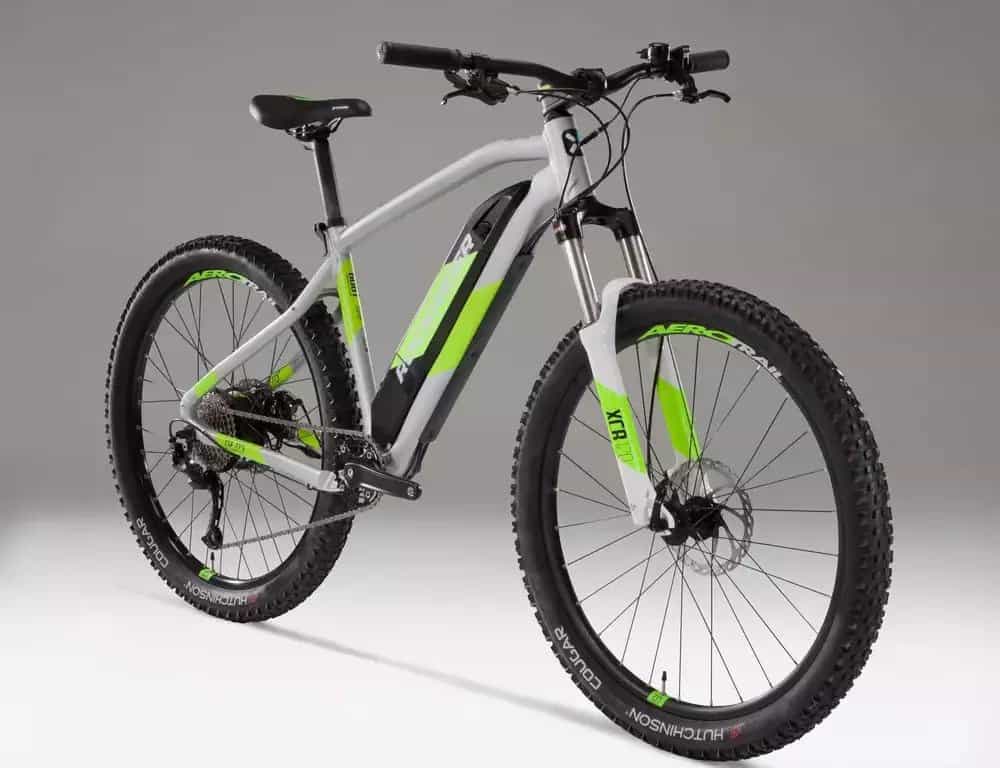
Decathlon has finally considered giving attention to its electric bicycle that it deserves. The launch and arrival of the new model, E-ST500, an entry-level electric bike, without comprising the main faults of the predecessor, is the best proof of this.
Keep reading if you are up for a detailed review of this well-done electric mountain bike.
Table of Contents
Pros
- Good value for money.
- Design.
- Torque sensor and controller.
Cons
- Mechanical disc brakes.
- Low range transmission.
- Plastic finishes.
Decathlon Rockrider E-ST 500: a solid starter eMTB
It won’t be wrong to say that Decathlon got very late in launching its first electric mountain bike. While some of the best sports specialists are already planning on launching their third-generation e-bikes, Decathlon, one of the best sports specialists in France and across the world, just came into the competition by launching its very first entry-level eMTB model.
Speaking of E-ST500, it is a slight evolution of Decathlon’s own mountain bike, the one that’s in the store catalog for a very long time now. Not much attention was paid by Decathlon to the design as well as the frame. We found them just the same as their mountain bicycles.
Read also: How to select your first electric mountain bike? And, How much does a good eMTB e-bike cost?
The new model, E-ST500, houses a brand-new control display as well as an electric motor for above-average performance and smooth pedaling in the mountains.
This model was launched to clear the air from the first E-ST500 model, as it had mixed reviews from those who use it.
Decathlon Rockrider E-ST 500 design: evolution is hidden in the details
The E-ST500 V2 model has the same aluminum frame, correctly polished and finished in black and blue tones. Other than that, the massive thick tubes and wheels give an impression that this model is not constrained by its weight. (It weighs 23 kgs).
However, as it is an entry-level model, its design fairly justifies it. We found a significant amount of plastic around the battery fixing system, along with prominent coarse finishes. We bet such massive amounts of plastic won’t be able to hold the frame together for a long time.
The level of battery integration is pretty basic but is justifiable and quite normal, given that its price range is low. As far as we know, you will get semi-integrated batteries by paying an extra 1000 euros.

The new control display is the main evolution in the Decathlon E-ST 500 V2, as compared to V1. The external development is quite discreet. The new display is certainly of high quality. Even though it is a basic display that allows the rider to entice information such as autonomy, level of pedal assistance, and instantaneous speed, it is quite different than the ones in traditional electric mountain bikes.
In this version, Decathlon decided to remove the USB port, which was integrated beside the control display of the first model. Therefore, it won’t be possible to charge your phone anymore while you ride your eMTB.
We are sure that Decathlon did it for a certain reason. But anyhow, it increases the bike’s reliability because, in the first model, users reported that their control display suffered from water infiltration, which was mostly coming via the USB port. This caused certain fragility in the model.
Read also: Selection of our favorite e-bike accessories to help you find the right gear for your needs.
The new control display that Decathlon has integrated into E-ST500 v2 is pretty basic and not that rich in functionality, but it increases the bike’s reliability. It won’t be wrong to say that as it wins in reliability, it loses in practicality.
Equipment and accessories: compromise comes at a cost
A quality frame is not enough to make a high-quality electrically-assisted mountain bike. The choice of equipment, accessories, and level of integration in the entry-level model are some other factors to consider. Most riders do not compromise on these attributes.
It is undoubtedly the same logic that prevails in the choice of brakes. Between entry-level hydraulic disc brakes and advanced mechanical disk brakes, Decathlon decided to opt for option 2. Even though this choice is less preferred by mountain bikers, it is justifiable economically.
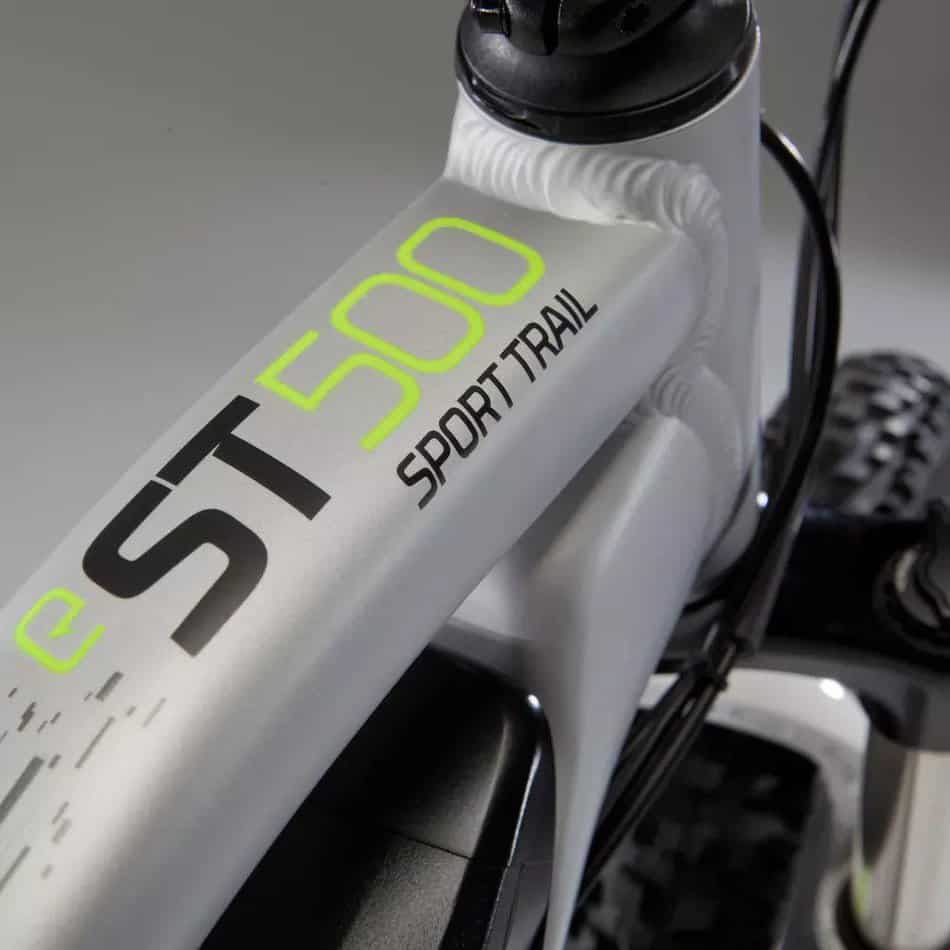
However, the performances of both types of brakes are somewhat similar, but only on dry grounds. But the feeling of progressiveness in braking is not quite the same in advanced mechanical disk brakes. In our opinion, it is a little bit of a handicap, especially on a demanding and hilly course.
If you are to compare the Decathlon E-ST 500 V2 to one of its serious competitors, the Intersport Nakamura E-Summit 710 opted rightly for hydraulic disc brakes in its entry-level model.
Looking at the level of transmission, it is clear that this is one of the main weaknesses of Decathlon Rockrider E-ST 500 V2. Decathlon chose an entry-level transmission system, the Shimano Altus.
This choice is good and logical to consider for a mountain bike, but only in economic terms. It does not correspond to the choice of electrification.
Read also: How to use gears on an electric bike (mechanic and electric)? And, How to switch electric assistance levels on an e-bike?
Due to this choice, the Rockrider e-bike rider will suffer from all fast gear changes or when the pedaling becomes heavy. The second defect can easily be corrected by keeping your hand on the gear lever but this position somehow forces the cyclist to divert his attention to the transmission when it should be managed instinctively.
On the other hand, we appreciate the choice of the fork with the Suntour XCR (120mm of travel). This choice does not only offer value for money but great performance for an amateur mountain cyclist.
Efficient but inconsistent electric power
The 250-watt motor is located in the rear hub. It is an option that is far less efficient than a mid-drive motor for an eMTB, but it is also the most economical. Indeed, you must invest an additional 800 euros and switch to the e-ST900 to benefit from a mid-drive motor if you are choosing from Decathlon’s line of e-bikes.
This hub motor was developed in partnership with the Chinese firm Vision and gives 42 Nm of torque, which is enough to overcome some bumps on the course but will not be enough for an “All Mountain” practice.
In this case, it is less about the engine itself and more about the torque controller, which was the subject of modifications between the previous model and this V2. This sensor (torque controller) is now designed by Decathlon in its Dieppe factory.
Read also: Can e-bikes help go up steep hills? And, How to switch electric assistance levels on an e-bike?
This change aims to improve the performance of the engine so that it provides more natural sensations. With a torque controller, we are no longer facing just a basic electrical engine that deploys all the power that it is capable of at once.
There is indeed a noticeable variation from the previous model, primarily when it is done under your foot. This sensing depends on the intensity of the pedal stroke, but it does not bother you much.
As for electric assistance, we appreciate that Decathlon has limited the choice to three levels only (low/medium/strong). But we wonder about its adjustments.
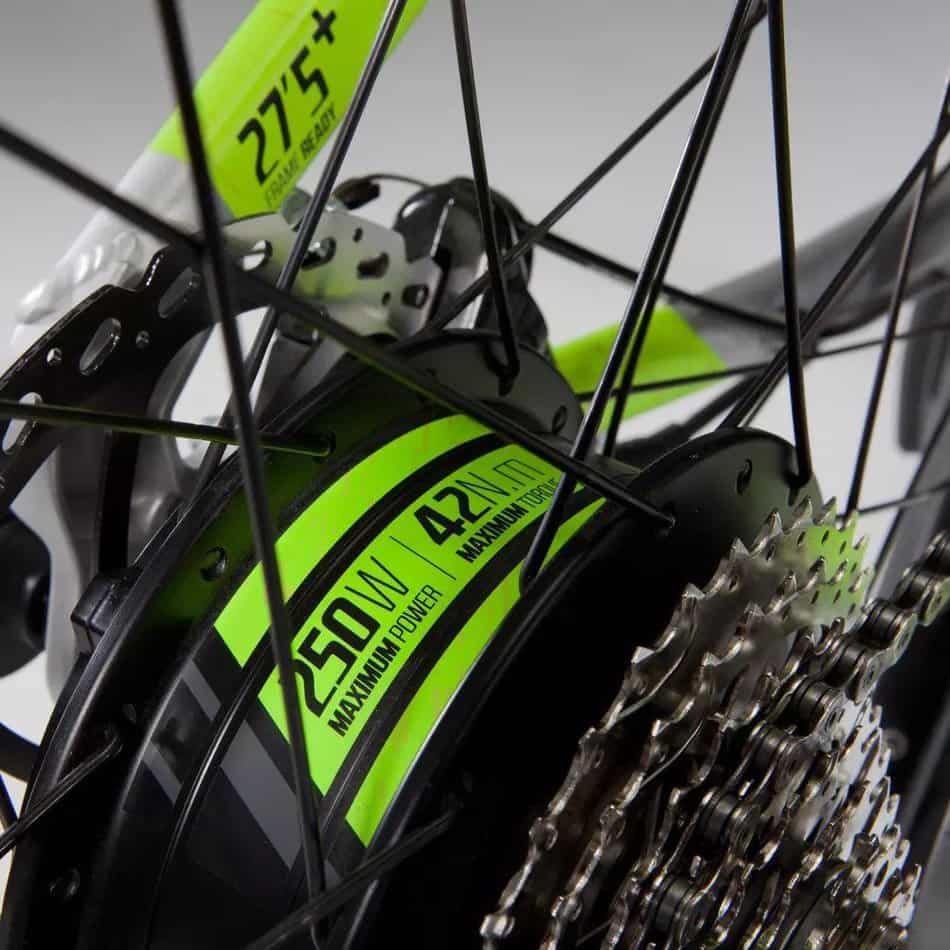
Indeed, at the highest level, it is more than enough power to help move you and your e-bike when you put your foot on the pedal to put your foot on the pedal. It is a deliberate choice of the manufacturer, and the explanation is quite simple. The torque sensor present on a hub motor is less precise than on a mid-drive motor. In the case of E-ST 500 V2, the motor can’t capture power from both sides. The assistance starts automatically as soon as the cyclist reaches 20 rpm.
On the two lowest pedal assistance levels, the above setting prevails and makes sense. On the contrary, the engine torque is available immediately for the highest level of pedal assistance. This setting is perfectly suited for the rider who is going for an “All Mountain” e-cycling experience.
In the end, we appreciate Decathlon’s efforts in bringing up an electric mountain bike almost as good as their traditional competitors but at an affordable price. However, this experience is still far away from the sensations and chills that Yamaha and Bosch engines could give their riders.
Decathlon Rockrider E-ST 500 on the road: responsive, pleasant, and reassuring
The preferred terrain or course for E-ST500 V2 is, of course, forest trails. Their muddy bumps are what separates them from traditional roads. But despite it being a mountain e-bike, it is also good to give a try to Decathlon Rockrider E-ST 500 V2 in an urban environment to see how well it performs as an urban electric bike.
At this very point, the Rockrider e-bike was quite surprising. Despite this e-bike having its massive tires with heavily imposed studs, it feels pleasant to ride this it on paved roads.
Read also: Can e-bikes help climb steep hills? And, How safe are electric bikes?
As the riding position is very high for a traditional mountain bike, Rockrider E-ST500 V2 offers more assistance on the roads. Due to its frame length, this e-bike is not suitable if you are going to rush into small spaces while riding.
Despite being not bad in an urban environment, Decathlon E-ST500 V2’s preferred terrain remains forest and nature, as it was designed for. The distinctive geometry of the well-calibrated frame brings it closer to the muscular mountain bike that every mountain biker wishes for.
The Decathlon Rockrider E-ST 500 is almost as responsive as a conventional mountain bike. The rider can adapt to how to use this model, its frame, and its electric assistance in no time as soon as one starts using this e-bike.
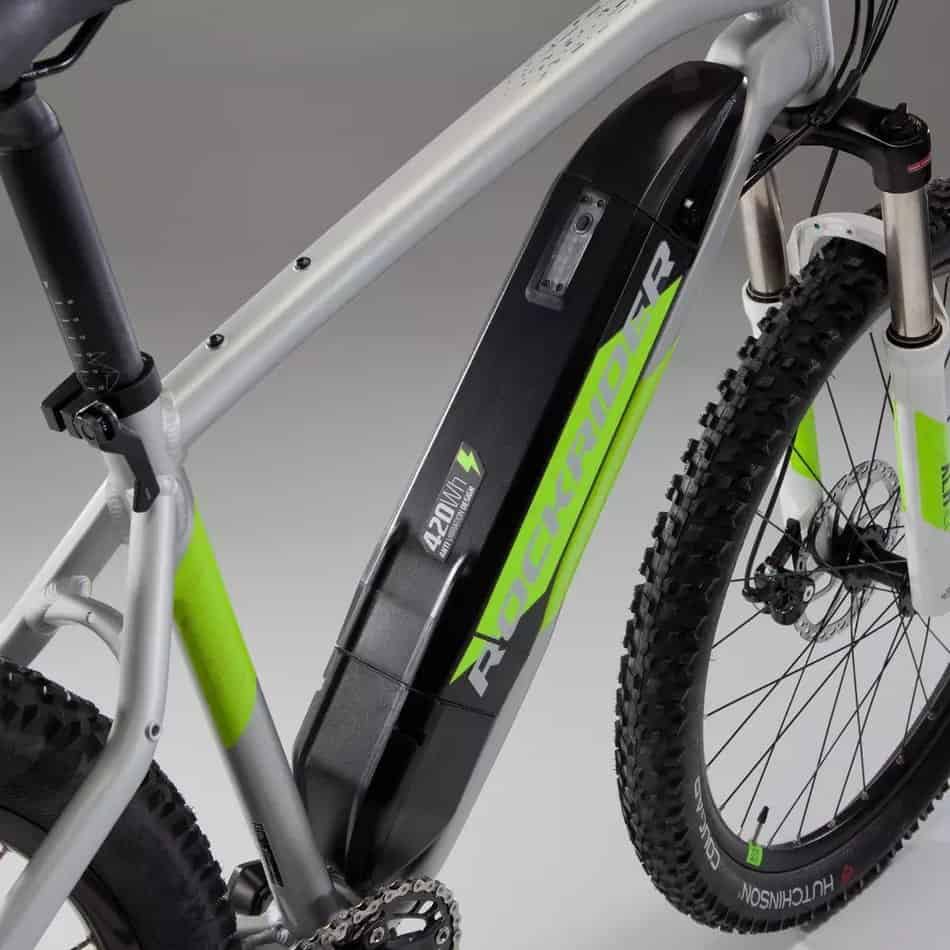
To enhance the biker’s experience, we could suggest Decathlon develop a mobile app for its electrically assisted bikes. The mobile app could be used to anticipate its maintenance as well as manage and observe the eMTB performance on the course.
Hopefully, this change will come in the next generation of Decathlon’s electrically assisted bikes.
Autonomy: Rockrider keeps its promise
Decathlon does not take the risk of indicating a minimum mileage for the Decathlon Rockrider E-ST 500. The indications say that the 420-Watt battery should be enough for a 2-hour and 30-minute ride.
If you would like to calculate more precise metrics, you will need to dig through documentation to the page that estimates the autonomy of the bicycle and takes into account the size of the rider, his weight, and the type of ride.
In reality, the 420-Watt battery, made up of LG cells, offers perfectly adequate performance at this price level. But it depends on the route taken by the cyclist and his body size.
Read also: What is the difference between e-bike batteries? And, How far can e-bikes go? What is the e-bike range?
However, it also varies considerably, depending on the level of pedal assistance required by the cyclist. At the second level of assistance, out of three, it should be possible to reach around 70 km of autonomy on an urban and relatively flat route.
On the other hand, in the forest, on particularly muddy and hilly terrain, the battery would suffer more significantly.

In any case, the autonomy performance of the Decathlon Rockrider E-ST 500 remained very honest, considering its price.
Decathlon Rockrider E-ST 500 data sheet
Technical characteristics
| Type(s) | Mountain electric bicycle |
| Mobile app | No |
| Engine power | 250 Watt |
| Wheel diameter | 27.5” |
| Transmission type | Chain |
| Suspension | Front |
| Number of speed levels | 9 |
| Folding | No |
| Lighting | Yes |
| Braking | Discs |
| USB port to charge the phone | No |
| Accessories | 2 keys for locking the battery, power cable, power adapter |
Electric Power
| Battery Power | 420 Watt |
| Battery Capacity | 11600 mAh |
| Removable Battery | Yes |
| Autonomy Announced | 2 hours and 30 minutes |
Dimensions and Weights
| Length | 186 cm |
| Height | 101 cm |
| Weight (including battery) | 23 kgs |
Final remarks about Decathlon Rockrider E-ST500
Decathlon’s second version of E-ST 500 is an evolution that’s openly welcomed and appreciated in mountain e-biking. The entry-level model of Decathlon gains in comfort and reliability but lacks in practicality.
Read also: Is Decathlon a good e-bike brand to buy? Brand and models review.
Having a torque sensor is quite rare for a 1200 euros electric bike. This feature needs to be well highlighted in the documentation as well.
However, to make up for the delay in entering the competition, Decathlon could have equipped the second version with hydraulic disc brakes and higher-range transmission.
But all the above shortcomings are well mitigated if we look at the overall quality of Decathlon’s new entry-level eMTB model. This e-bike is sure to give the cyclist a wonderful experience of mountain biking.
Read also: Check out reviews of popular models of electric bikes.
Igor is a sustainable mobility and green energy advocate. His mission for Easy E-biking is to help make electric cycling simple, practical, and fun. Follow him on Facebook and LinkedIn.

